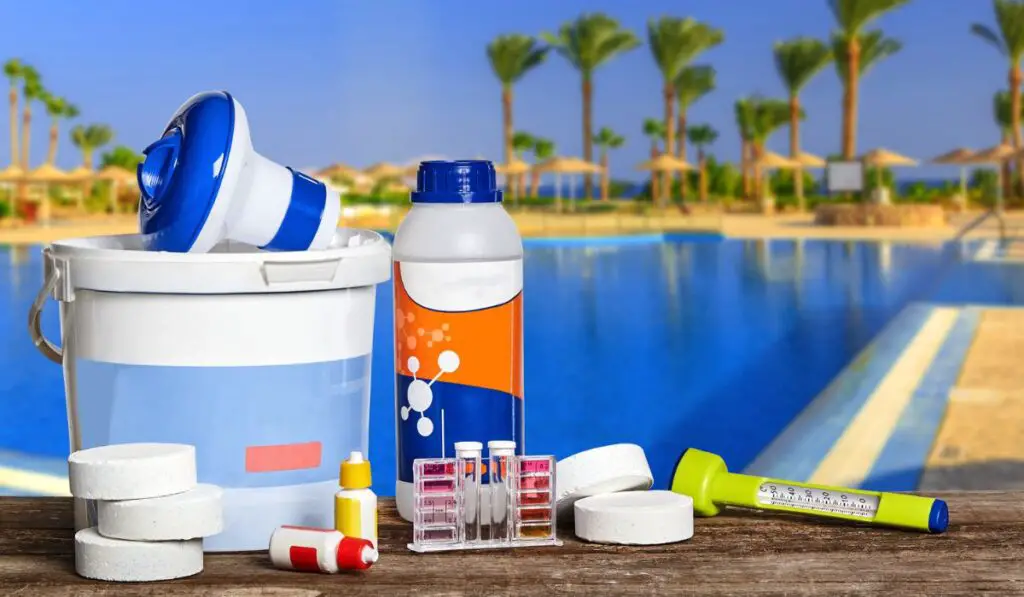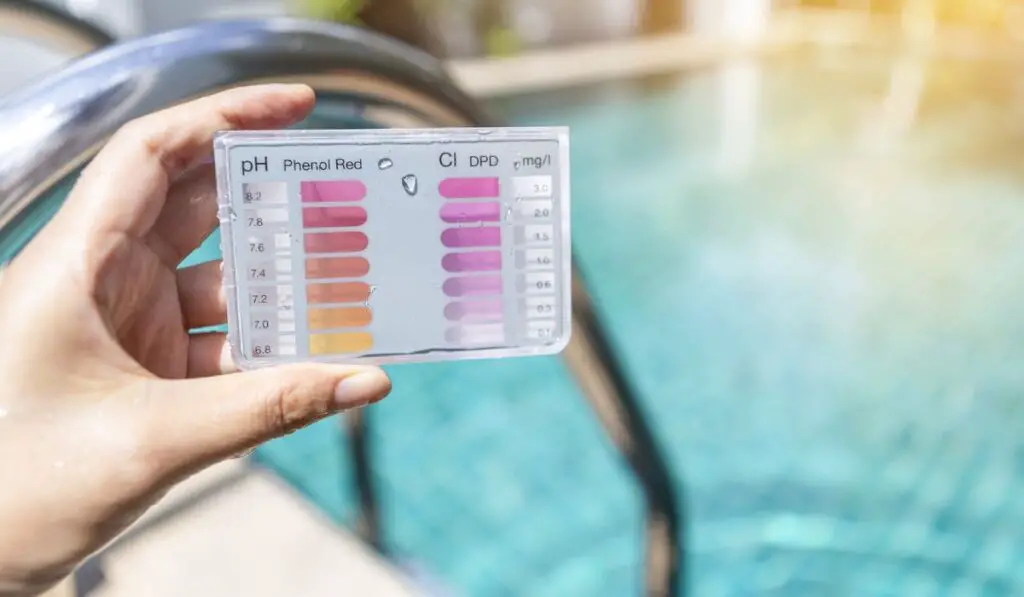Whether you’re a seasoned pool owner or a completely new one, it’s extremely important to shock your pool. Don’t worry; this has nothing to do with electricity — and you won’t be risking injury in the process.
Shocking a pool is the process of adding chemicals to quickly increase its free chlorine levels. While it’s easier to maintain the same(ish) chlorine level all the time, shocking is a way to quickly clean up a dirty pool if you’re in a pinch, or to respond to something like a high rainfall event.
If you don’t treat your pool, you’ll compromise the cleanliness, safety, and overall sanitary conditions of your pool. Let’s look at what exactly shocking a pool entails before moving on to the types of chlorine and pool shocks available as well as the steps you need to take to shock your swimming pool. While some prefer saltwater systems or other methods of disinfecting their pools, shocking periodically gets the job done too.
What Is Pool Shock?

Pool shock is essentially a granular oxidizer used for treating pool water. So, when you “shock” your pool, you’re essentially adding non-chlorine or chlorine pool chemicals to increase the level of “free chlorine” in the water.
A higher free chlorine level helps destroy contaminants such as chloramines, bacteria, and algae, ensuring your pool is completely clean and safe to swim in.
Is Pool Shocking Necessary?
You could argue that normal, every-day disinfection is technically “shocking”, and many pol owners believe this to be the case. That’s because they may buy pool shock, put it in weekly (for instance) and get good results, so they simply think that’t the right way to get those practical results. They’re not wrong.
But really, shocking a pool is more of a thing you do when normal pool management goes off the rails. A normal, well-balanced pool with a saltwater system or a floater that has chlorine pucks in it doesn’t need “shocking,” because it’s just consistently balanced.
So is shocking necessary? Not all the time, but treatment of some kind IS definitely necessary all of the time. Shocking, instead, is more of a maintenance technique: if your water is cloudy or green you can choose to slowly fix that problem, or if you’re in a rush you can decide instead to shock it, which will get you better results quicker.
For the rest of this post, we’re basically going to use the terms “shocking” and “treatment” interchangeably, which reflects how many consumers think about these terms, but be sure to scroll back to this important distinction if you get confused!
Types of Chlorine and Pool Shock
There are several different types of chlorine present in your pool, such as:
Free Chlorine (FC): This is the chlorine that actively disinfects your water. It’s advisable to keep the water’s FC level between 1 and 3 ppm (parts per million), so that the chemical can properly decontaminate your pool.
Combined Chlorine (CC): This is the total amount of chlorine that has already been used. CC is present in your pool water, but its effectiveness is greatly reduced. It’s better to keep the CC level below 0.2 parts per million.
Total Chlorine (TC): This is the sum of CC and FC in your pool. Most pool water testing kits measure the TC and FC of your water. You can easily find the combined chlorine of the water by subtracting the free chlorine from the total chlorine.
Breakpoint Chlorination: This is the point where you have enough free chlorine to destroy chloramine at the molecular level. This point can only be achieved if you add ten times more free chlorine than combined chlorine to your pool.
It’s important to reach this breakpoint whenever you shock a pool. Failing to reach this breakpoint can actually increase the amount of chloramines in your swimming pool, and you might have to partly or fully replace the pool water to fix the problem.
Types of Pool Shock
Along with different kinds of chlorine, there are also several different types of pool shocks you can choose from. Some of the most common ones include:
Calcium Hypochlorite Shock
Cal hypo (on Amazon) is one of the most convenient and inexpensive ways to shock your swimming pool. It contains around 65% to 75% chlorine and has been used to disinfect municipal water sources and pools since 1928.
Lithium Hypochlorite Shock
If your pool water has high calcium content and you’re willing to spend a bit extra, then lithium hypochlorite is the best option for you.
It contains around 35% chlorine and dissolves at a much faster rate than cal hypo, so you can directly add it to the pool without dissolving it in water beforehand.
However, the chemical is toxic to aquatic life, so make sure you take the proper precautions when disposing of it.
Dichlor Shock
Also known as dichloroisocyanuric acid and sodium dichloro-s-triazinetrione, dichlor shock (on Amazon) is easier to use than it is to pronounce. In fact, some brands allow you to add the chemical directly to the pool water.
It contains around 50% to 60% chlorine and works as both shock treatments and regular chlorine doses. You can use the chemical to shock saltwater pools as well.
Non-Chlorine Shock
If you want to shock your swimming pool and dive into it soon afterward, then a non-chlorine shock (on Amazon) is the way to go. It uses potassium peroxymonosulfate, which is a fast, cheap pool shock alternative that works wonders on saltwater pools.
However, since it doesn’t contain chlorine, it doesn’t kill algae.
How to Shock a Pool

It’s better to shock a pool at night, or the sun will burn off the unstabilized chlorine that makes pool shocks effective. Also, don’t forget to wear safety glasses and gloves before shocking your pool.
Here are the steps you need to follow:
- Test the pH level of the pool water. It’s also advisable to use a pool test kit (on Amazon) to calculate the combined chlorine or the total amount of chlorine you need to add to your pool water.
- Calculate the total amount of pool shock you need to add. You can do this by following the instructions written on the package of the chemical you plan to use.
- Some pool shocks can be added to the pool directly, but most need to be dissolved in water before use. It’s advisable to prepare the pool shock beforehand, as this will help save time and prevent calculation errors.
- Turn on the pool pump.
- Add the prepared mixture into the pool water, preferably around the pool’s edges.
- Let the pool pump run for around six hours or more if needed.
- Test the chlorine levels of the water to ensure you’ve reached breakpoint chlorination.
Don’t jump into the swimming pool right away. Wait until the free chlorine levels drop to somewhere between 1 and 3 ppm.
How Often Should You Shock a Swimming Pool?
If shocking is your primary treatment method, it’s advisable to shock your swimming pool at least once every two weeks, or once every week to maintain sanitized and balanced water chemistry. The more you use your pool, the more you should shock it.
Along with the semi-weekly or weekly treatments, you should also perform an additional pool shock after a big water level change, severe rainstorm, contamination event (like a pet pooping in the pool), or a pool party where lots of people helped make the water dirtier than it usually is by just being in there.
These extra shocks will help protect your pool water from wayward algae, bacteria, and other contaminants, eliminating them before they negatively affect the water quality or make anyone sick.
Tips and Tricks
Here are a few tips and tricks that can help ensure a clean and bacteria-free pool:
- Shock the pool if the combined chlorine level is lower than 0.5 ppm.
- Make sure you face upwind when adding shock to your pool, so it does not come into contact with your face or eyes.
- Don’t add pool shock to the skimmer, as doing so can damage it. Only add the chemical over the surface of the pool water so it has a chance to dissolve.
- Don’t jump into the pool immediately after shocking the pool. Instead, follow the time limit given by your particular pool shock.
- Don’t cover the pool if the chlorine levels are above 5ppm.
- Rinse the empty shock bag in the pool before disposing of it.
- Never store partial bags of pool shock. Use new, full ones every time. This way you don’t have any guesswork about how much of which chemicals you’ve added.
